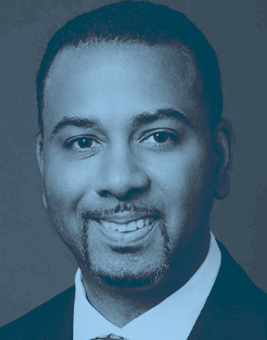
Data & Blueberries: A One-on-One with Kroger Health’s CMO
Trust, data, history and perspective.

Watkins
Those assets enable grocery retail giant Kroger to fit into America’s healthcare ecosystem, according to Marc Watkins, MD, Kroger Health’s chief medical officer.
As Watkins describes it, virtually all of Kroger touches “healthcare” through its grocery stores, pharmacies and walk-in Little Clinics. Combined with the data-crunching that takes place in the background, the massive enterprise has the potential to spur change at the level of individual consumers – moving people to make health-related decisions ranging from getting vaccinated to buying nutritious foods.

To realize that near-future state, Kroger is relying on established trust, its wealth of consumer data, a long and positive legacy and a clear, aligned perspective on where the organization is headed.
We recently spoke with Watkins about Kroger Health’s approach to consumerization of healthcare. Their stated mission is to “Simplify Healthcare by creating solutions that combine health, wellness, and nutrition by connecting with Customers on an emotional and personal level.”
Here, he uses the language of retail to provide his takes on the coming revolution in healthcare.
Trust
Kroger stores are located in every type of community across America and serve an array of demographics. Just how does this massive corporation think about outreach and interaction with customers?
It starts by being a reflection of the communities served and carrying what that population desires. “If people don’t feel comfortable, don’t feel like they can get the things they need, then we’re not a destination,” Watkins said.
He doesn’t take for granted the robust community trust earned over the company’s 130-year history. The grocer seeks to retain trust with each customer interaction and by ensuring the right items are on the right shelves in the right stores. Those provisions, he added, extend naturally to the healthcare.
“We have to deliver our healthcare solutions the same way we’ve earned your business in our stores,” he said. “And it’s natural, because nurses and pharmacists are some of the most approachable healthcare professionals.” And, as we’ve seen, among the most trusted.
Data
Like any large consumer brand, Kroger collects and analyzes customer data to dial in its offerings, working in tandem with its tech partners at 84.51° who help the retailer look at consumer insights and purchase data to shape personalized experiences. That intelligence about you and your shopping habits is then extended to your Kroger Health experience, so “we can personalize our interventions and meet you in a way that connects on an individual, emotional level,” he said. “For example, personalizing food recommendations for a diabetic, or using the data to help patients to be more compliant with their medications.”
History
“We do millions of flu shots a year. We have the muscle memory of giving shots. Our pharmacies have been giving vaccines for decades.” That was Watkins’ response when we asked about our February survey results showing that people preferred to receive a COVID-19 vaccine at their doctors’ office rather than a retail clinic. He noted that, as a retailer, Kroger is well aware that people have choices in what they buy and where they buy it. And as many people have been comfortable receiving annual flu shots at retail clinics, moving to COVID-19 vaccinations was a no-brainer alternative.
In addition, Watkins said, “Before the pandemic, our clinicians and pharmacists worked to close as many gaps in care as we could, which included assigning age-appropriate vaccines to our patients. So, vaccines were an existing part of our clinical programming.”
Perspective
With history comes perspective. Watkins repeatedly referenced the philosophy at Kroger Health, which revolves around a holistic view of individuals and their needs. “Our vision,” he said, “is to help people live healthier lives.”
Beyond personalization through data, Watkins discussed the importance of simplifying healthcare by creating solutions that combine health, wellness and nutrition – and by connecting to people on an emotional level. Being a century-old grocer, that starts with food and goes from there.
“We have an aggressive food-as-managed medicine strategy,” Watkins explained. “It looks to prevent diseases before they start.”
He noted that it’s not enough for healthy food to be available, it also needs to be “fun.” People need to enjoy eating to drive the change necessary to realize health benefits. And then, the food-as-medicine approach can be linked to the primary care and pharmacy services available through Kroger Little Clinics to provide something closer to holistic care.
The organization has lofty goals for this work. Watkins said they’re pushing to reduce the incidence of obesity, diabetes and food insecurity by 20 percent by 2025. Furthermore, they’re coordinating with consumer packaged-goods partners to cut $58 billion from the cost of food on Kroger shelves by 2025, effectively removing the myth that eating healthy “is expensive and not fun.”
Perspective also involves Kroger’s view of its own position within the constellation of both healthcare and retail. To achieve that $58 billion reduction, Kroger is using its weight as a grocery giant, incentivizing partners with shelf space to deliver healthier products at lower cost. That’s on the retail side.
On the healthcare side, Watkins noted that the traditional providers (hospitals, clinics, physician offices, etc.) are in a tough spot because of declining reimbursement and rising pay and overhead. “Traditional providers need to think about their influence with patients,” he said. “Patients are choosing more than they have before, and they’re looking for alternative places to receive care.” Finally, finite capitation is coming and “CMS has said very clearly that they want out of downside risk. Direct contracting entities are standing up, and they’re going to want value for that service.”
What’s next?
Asked to look into the crystal ball and predict healthcare’s consumer evolution, Watkins demurred, reminding us that such forecasting is tough – even for Kroger. Instead, he offered a few areas that must be addressed.
Public health: “We need to look at our public health response and dissect what went wrong – and what went right.”
Inequity: “Health disparities were laid bare by this pandemic. Communities of color continue to over-index in hospitalizations and deaths from COVID-19, but they have some of the lowest vaccination rates. We have to dispel myths and address (with financial commitments) the reasons behind ongoing health disparities, including systemic, historical racism.”
Medicaid: “Medicaid was expanded and then the rolls were frozen. States have to find ways to combat rising costs because more folks have been displaced economically during the pandemic.”
Where does Kroger fit in to the above?
“We are part of the fabric of the community,” Watkins said. “I’ve often joked that you see all comers at the grocery store, the emergency department and the county jail. As a grocery store, we’re deeply invested in providing people the opportunity to live healthier lives.”
Takeaways for healthcare providers
*stats from Kroger and Statista (2016)
